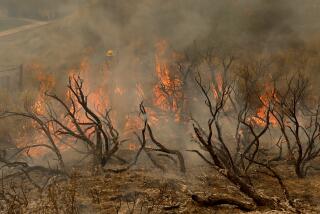Up to 9 Homes Burn; More Threatened
- Share via
MORONGO VALLEY, Calif. — Southern California’s wildfire season began in earnest Wednesday as dry, hot conditions and steady winds fanned six separate blazes across the region, the most serious of which destroyed up to nine homes and blackened 4,500 acres of desert 120 miles east of Los Angeles.
Five of the blazes were in Riverside and San Bernardino counties. Combined, they threatened more than 700 homes over more than 8,500 acres as fire crews and water-dropping aircraft struggled to contain them.
Stoked by triple-digit temperatures and fueled by dry, dense grasses that sprang up after near-record rainfall last winter, flames reached more than 30 feet high as firefighters ordered evacuations near Big Morongo Canyon Reserve. The wildfire began as a house fire about 1 p.m., and within hours the flames had covered more than 1,000 acres and were “burning in and around” the many ranch homes and horse corrals scattered throughout the rugged Mojave Desert valley, according to the San Bernardino County Fire Department.
The fire, which was burning out of control to the northeast and approaching Yucca Valley on Wednesday evening, left a scorched landscape of charred scrub, smoking palm trees and chimneys jutting up from leveled homes.
“It was like a big inferno on the mountainside,” said Morongo Valley resident Lori Weeks, 27. “I’ve never seen anything like that here.”
The five fires in Riverside and San Bernardino counties broke out within half an hour of one another, placing an immediate strain on local firefighting resources.
Two of the fires erupted near the remote Hackberry Mountains in the eastern Mojave Desert. Despite the efforts of federal Bureau of Land Management crews, the two fires converged and spread over more than 2,500 acres. No structures were reported damaged or threatened.
In Bent, near Helendale, a blaze consumed 30 acres of brush, but no structures in a nearby residential area were damaged.
In Riverside County, another wildfire burned near the Soboba Band of Luiseno Indians’ reservation, northeast of Hemet. More than 1,000 firefighters, three helicopters, six water-dropping airplanes and six bulldozers attacked the blaze, which had spread to more than 2,000 acres by Wednesday evening. Although the fire burned just several thousand yards from the Soboba Casino, there were no reports of injuries or homes lost, authorities said.
A far smaller fire in Santa Clarita, in Los Angeles County, scorched about 15 acres of brush but threatened no homes, authorities said.
But it was the Paradise fire in Morongo Valley that caused the most damage and posed the greatest risk to homes.
Authorities closed a two-mile stretch of the Twentynine Palms Highway, several miles north of Palm Springs, when the fire jumped the asphalt and approached homes on both sides of the road. The closure caused great anxiety among residents racing to their homes Wednesday afternoon.
“It’s frustrating. I can’t go up and help anybody,” said Ed Maloof, 46, as he waited in traffic. “I have six horses in my house, and I need to get them moved.”
Maloof said he was considering ignoring the CHP officers who stopped him. “They said, ‘If you go around me, I’m writing you a ticket.’ I haven’t reached that point yet, but I’m close.”
By early evening, at least two dozen evacuees had gathered at the local Moose Lodge, where the Red Cross had established a shelter.
Residents whose homes were spared when the fire suddenly switched direction described watching neighbors’ houses burn beneath ash-gray skies as they sprayed their own homes with garden hoses.
Helen Johnson, 76, feared her house was in the fire’s path as she watched a hillside burn across the street from her porch.
“It’s kind of scary,” said Johnson, who packed her cat, Babe, into a carrier and threw cat food, clothes and water in the car, thinking she might have to flee.
The air, filled with white and gray smoke, turned black when flames flared up, making it difficult to breathe, Johnson said. “It was horrible. Especially when it’s bearing down on you -- you didn’t know if it was going to get you or not.”
Conrad Zimmerman, 17, was working as a cook at the Spunky Monkey restaurant, where the patrons were chatting about the Paradise fire jumping Highway 62 -- near his step-grandparents’ house.
Zimmerman ran to the house. “When we got there, the entire backyard was on fire,” he said. He borrowed a hose from a friend, covered his mouth with his tank top and started battling the flames burning across the grass, brush and in small patches on trees.
He realized that neighbors’ yards were also aflame, and that the blaze was moving toward his step-grandparents’ home -- which was empty while they vacationed in Illinois.
“I felt pretty good about it,” Zimmerman said of his attempt at firefighting. “My confidence is up right now. I always wanted to be a hero, and I finally got a chance to play it today.” The home was saved.
When firefighters arrived on the scene, they gave him tips like not letting small fires burn until they get out of control, wetting homes’ roofs to stop the flames and wearing a long-sleeved shirt for protection.
The firefighters praised Zimmerman, who said he felt dizzy and whose eyes were reddened by smoke, for his work. Zimmerman wants to join the Army but is now considering becoming a firefighter.
“I wasn’t scared -- it was exciting,” he said. Because he is between homes and staying with friends, he said, it felt good to save someone else’s home.
Another resident who battled to save homes was helicopter pilot Steve DeJesus. The pilot, said his wife, Dee Dee DeJesus, flew sorties over their home, dipping the helicopter’s water bucket into their above-ground pool and flying on to wildfire hot spots to the east.
Primary responsibility for fighting the Paradise fire has fallen to the California Department of Forestry and Fire Protection. The blaze appeared to slow as the sun fell and the air cooled, but authorities said that their work would be cut out for them if the heat and winds returned today. They said the remote location of the fire also posed difficulties.
“With all the fine fuels out here -- the grass from the winter rains -- it’s ready to burn very easy,” said CDF spokesman Bill Peters. “We’re still working on a plan of attack for [today].
“We’re finally getting large amounts of resources in here.... It takes a long time to get in here. It’s an extra hour from wherever.”
*
Times staff writers Susannah Rosenblatt, Stephanie Ramos and Monte Morin contributed to this report.
More to Read
Sign up for Essential California
The most important California stories and recommendations in your inbox every morning.
You may occasionally receive promotional content from the Los Angeles Times.











